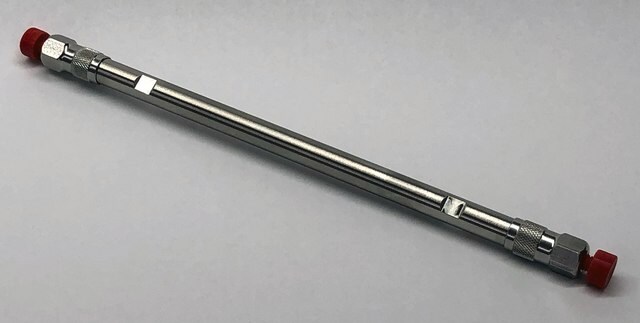581616-U
Ascentis® Phenyl (5 µm) HPLC Columns
L × I.D. 15 cm × 4.6 mm, HPLC Column
Synonym(s):
Phenyl HPLC Column
About This Item
Recommended Products
product name
Ascentis® Phenyl HPLC Column, 5 μm particle size, L × I.D. 15 cm × 4.6 mm
material
stainless steel column
Agency
suitable for USP L11
product line
Ascentis®
feature
endcapped
manufacturer/tradename
Ascentis®
packaging
1 ea of
extent of labeling
19% Carbon loading
parameter
≤70 °C temp. range
400 bar pressure (5801 psi)
technique(s)
HPLC: suitable
LC/MS: suitable
L × I.D.
15 cm × 4.6 mm
surface area
450 m2/g
surface coverage
5.2 μmol/m2
impurities
<5 ppm metals
matrix
fully porous particle
silica gel high purity, spherical
matrix active group
phenyl phase
particle size
5 μm
pore size
100 Å
operating pH range
2-8
application(s)
food and beverages
separation technique
reversed phase
Looking for similar products? Visit Product Comparison Guide
General description
The Ascentis Phenyl provides superior separations in reversed-phase mode including 100% aqueous conditions. It may also be used in HILIC/ANP (aqueous normal phase) mode and shows low UV/MS bleed for gradient applications.
Application
- A Different Perspective on the Characterization of a New Degradation Product of Flibanserin With HPLC-DAD-ESI-IT-TOF-MSn and Its Pharmaceutical Formulation Analysis With Inter-Laboratory Comparison: This study highlights the advanced chromatographic techniques used to characterize pharmaceutical compounds, demonstrating the importance of accurate and detailed analysis in pharmaceutical research. The use of the Ascentis® Phenyl HPLC column facilitates high-resolution separations, essential for identifying degradation products in complex mixtures (Geven et al., 2023).
- HPLC with Spectrophotometric or Mass Spectrometric Detection for Quantifying Very-Long Chain Fatty Acids in Human Plasma and Its Association with Cardiac Risk Factors: This paper discusses the role of high-performance liquid chromatography (HPLC) in clinical settings, particularly for the assessment of biomarkers related to heart disease. Techniques involving the Ascentis® Phenyl HPLC column are employed to achieve precise and reliable quantification of fatty acids, critical for clinical diagnostics (Shrestha et al., 2021).
- A Fully Automated and Fast Method Using Direct Sample Injection Combined with Fused-Core Column On-Line SPE-HPLC for Determination of Ochratoxin A and Citrinin in Lager Beers: This study introduces an automated method for toxin analysis in beverages, utilizing the Ascentis® Phenyl HPLC column. The approach enhances sensitivity and throughput, showcasing the column′s efficacy in food safety applications (Lhotská et al., 2016).
- A Study of Retention Characteristics and Quality Control of Nutraceuticals Containing Resveratrol and Polydatin Using Fused-Core Column Chromatography: The research focuses on nutraceuticals, where the Ascentis® Phenyl HPLC column′s selectivity plays a pivotal role in segregating and analyzing health-promoting compounds, thereby ensuring product quality and compliance with industry standards (Fibigr et al., 2016).
- An On-Line SPE-HPLC Method for Effective Sample Preconcentration and Determination of Fenoxycarb and Cis, Trans-Permethrin in Surface Waters: This publication illustrates the application of the Ascentis® Phenyl HPLC column in environmental analysis, particularly for the sensitive detection of pesticides in water bodies. The column′s capabilities help in tracing low-level contaminants, critical for environmental monitoring and protection (Šatínský et al., 2015).
Features and Benefits
- 100% Aqueous Compatible
- ANP/HILIC and reversed-phase
- Low UV/MS bleed for gradient applications
- Alternate selectivity
Legal Information
guard cartridge
related product
Choose from one of the most recent versions:
Already Own This Product?
Find documentation for the products that you have recently purchased in the Document Library.
Our team of scientists has experience in all areas of research including Life Science, Material Science, Chemical Synthesis, Chromatography, Analytical and many others.
Contact Technical Service


